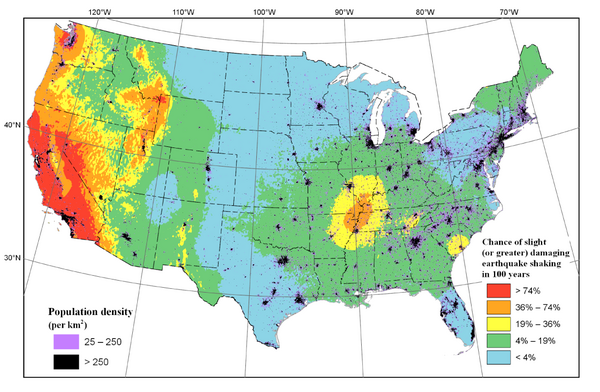Engineering and Risk Active
The well known statement "Earthquakes don't kill people, buildings do" highlights the need to make our communities more earthquake resilient. The impact of earthquakes on public safety and the national economy can be reduced through improvement of the built- environment to resist earthquake effects such as ground shaking. Reduction of the economic impact on individuals and the nation can also be reduced by additional means such as earthquake insurance.

The Engineering and Risk Project (ERP) is part of the Hazards, Impact, and Risk (HIR) sub-committee of Science Coordination Committee (SCC) of the USGS Earthquake Hazards Program (EHP). Two ERP tasks are currently identified to extend hazard science to engineering mitigation and risk reduction (i.e., improve ability of built environment to resist hazards). They both have research and outreach elements and are consisted of:
Task 1: Collaboration with external engineers and National Seismic Hazard Model (NSHM) project on earthquake ground motions for construction codes; with five current subtasks:
-
Research on earthquake ground motion maps for construction codes
-
Adoption of USGS earthquake hazard assessments into construction codes
-
Development of web services and data releases for dissemination of earthquake ground motion maps for construction codes
-
Simulation, validation, and utilization of earthquake ground motion time-series for building codes
-
Alternative ground motion intensity measures
Task 2: Extending natural hazards to risk; with five subtasks:
-
Seismic risk to critical infrastructure
-
Earthquake-induced ground failure forecasts
-
Earthquake ground-motion and impact scenarios
-
Multi-hazard risk assessment
-
Seismic safety of tall buildings and other long-period structures
These tasks and subtasks have been designed to collaborate with the internal community (e.g., the USGS NSHM Project, the USGS National Earthquake Information Center (NEIC)) to develop requisite data, methods, and tools for assessing risks to building and non-building infrastructure systems. The goals are achieved by collaborating with the external community (e.g., Building Seismic Safety Council (BSSC), Federal Emergency Management Agency (FEMA)) to assess design loads and mitigate seismic risk.
For More Information
- Design Ground Motions
- Earthquake Scenarios
- Engineering Risk Assessment Project Wiki - available soon
Engineering and Risk Project Team
Engineering and Risk Project Team: from left to right, Kishor Jaiswal, N. Simon Kwong, Rob Chase, Ben Mason, David Wald, Sanaz Rezaeian, Nico Luco, Andrew Makdisi, Eric Thompson, Zachary Kortum, Mark Peterson.
Hazard characterization for alternative intensity measures using the total probability theorem
- Overview
The well known statement "Earthquakes don't kill people, buildings do" highlights the need to make our communities more earthquake resilient. The impact of earthquakes on public safety and the national economy can be reduced through improvement of the built- environment to resist earthquake effects such as ground shaking. Reduction of the economic impact on individuals and the nation can also be reduced by additional means such as earthquake insurance.
 Sources/Usage: Public Domain. View Media Details
Sources/Usage: Public Domain. View Media DetailsUSGS map showing (1) the locations of major populations and (2) the chance of slight (or greater) damaging earthquake shaking occurring in 100 years. The Engineering and Risk Project (ERP) is part of the Hazards, Impact, and Risk (HIR) sub-committee of Science Coordination Committee (SCC) of the USGS Earthquake Hazards Program (EHP). Two ERP tasks are currently identified to extend hazard science to engineering mitigation and risk reduction (i.e., improve ability of built environment to resist hazards). They both have research and outreach elements and are consisted of:
Task 1: Collaboration with external engineers and National Seismic Hazard Model (NSHM) project on earthquake ground motions for construction codes; with five current subtasks:
-
Research on earthquake ground motion maps for construction codes
-
Adoption of USGS earthquake hazard assessments into construction codes
-
Development of web services and data releases for dissemination of earthquake ground motion maps for construction codes
-
Simulation, validation, and utilization of earthquake ground motion time-series for building codes
-
Alternative ground motion intensity measures
Task 2: Extending natural hazards to risk; with five subtasks:
-
Seismic risk to critical infrastructure
-
Earthquake-induced ground failure forecasts
-
Earthquake ground-motion and impact scenarios
-
Multi-hazard risk assessment
-
Seismic safety of tall buildings and other long-period structures
These tasks and subtasks have been designed to collaborate with the internal community (e.g., the USGS NSHM Project, the USGS National Earthquake Information Center (NEIC)) to develop requisite data, methods, and tools for assessing risks to building and non-building infrastructure systems. The goals are achieved by collaborating with the external community (e.g., Building Seismic Safety Council (BSSC), Federal Emergency Management Agency (FEMA)) to assess design loads and mitigate seismic risk.
For More Information
- Design Ground Motions
- Earthquake Scenarios
- Engineering Risk Assessment Project Wiki - available soon
-
- Multimedia
Engineering and Risk Project Team
Engineering and Risk Project Team: from left to right, Kishor Jaiswal, N. Simon Kwong, Rob Chase, Ben Mason, David Wald, Sanaz Rezaeian, Nico Luco, Andrew Makdisi, Eric Thompson, Zachary Kortum, Mark Peterson.
- Publications
Hazard characterization for alternative intensity measures using the total probability theorem
Since their inception in the 1980s, simplified procedures for the analysis of liquefaction hazards have typically characterized seismic loading using a combination of peak ground acceleration and earthquake magnitude. However, more recent studies suggest that certain evolutionary intensity measures (IMs) such as Arias intensity or cumulative absolute velocity may be more efficient and sufficient pAuthorsMichael W. Greenfield, Andrew James Makdisi


